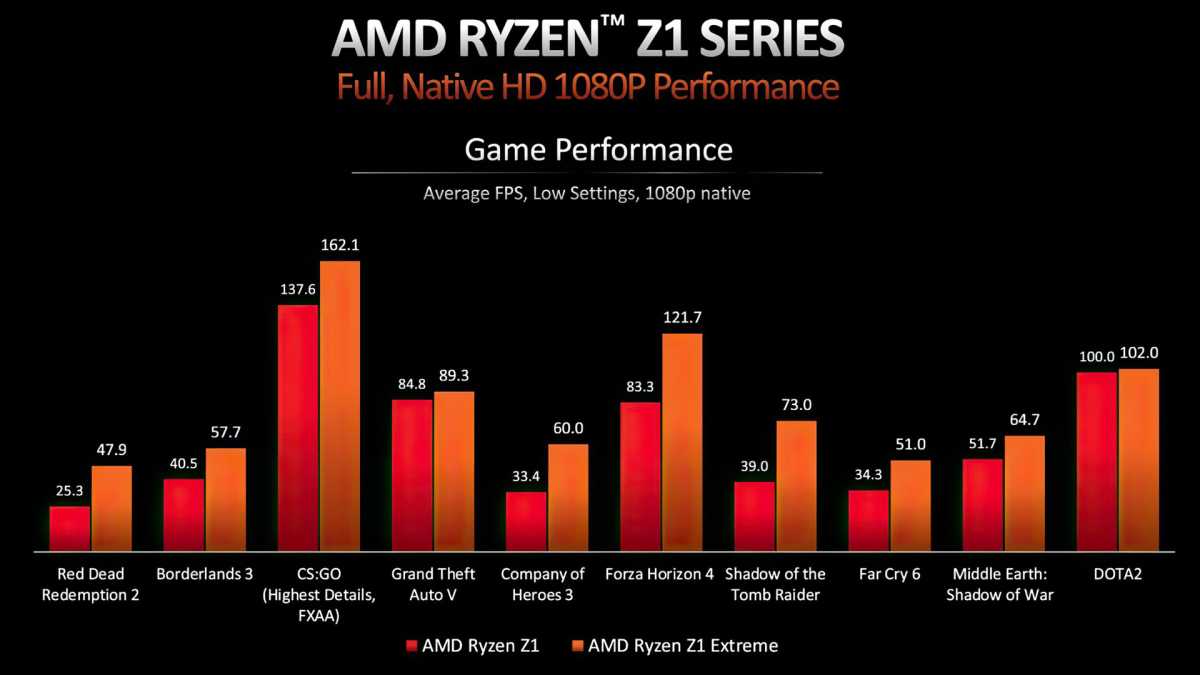It seems like the Steam Deck has dominated the PC gaming space for the last year, despite running on relatively old Zen 2 hardware. The fact that this brick-sized gadget can run the latest 3D PC games at all is pretty remarkable and a testament to the surprising versatility of AMD’s APU designs. But what if the company built a new series of chips designed from the ground up for this new, super-compact portable form factor? It has. Say hello to the Ryzen Z1, which will make its retail product debut in the Asus ROG Ally.
The Z1 and Z1 Extreme are designed with the unique requirements of super-portable gaming in mind, optimizing both graphical capability and battery life over multitasking or CPU-focused tasks. Both are based on the Zen 4 architecture of AMD’s latest desktop and laptop chips with the RDNA 3 graphics system. The Z1 boasts six primary cores and 12 threads, with four RDNA 3 compute units. The Z1 extreme gets a modest bump to 8 cores and 16 threads, but triples the RDNA 3 units to 12 to really pump out those polygons. Cache is 22MB and 24MB, respectively, and both processors support AMD’s Radeon Super Resolution, Image Sharpening, AMD Link streaming, and Radeon Chill power saving features.
But the real numbers that gamers care about are the in-game benchmarks. According to a promotional slide from AMD, the Z1 can handle 138 frames-per-second in Counter-Strike: GO at 1080p—about the same level as a budget or mid-range gaming desktop, depending on the settings. The Z1 Extreme can pump out 162 frames. A more demanding single-player game like Red Dead Redemption 2 is going to hit the hardware a lot harder, but it’s still very playable at 25 and 48 frames, respectively. Forza Horizon 4, a relatively well-optimized game that nonetheless benefits from higher framerates, is clocked at 83 FPS for the Z1 and an impressive 122 FPS for the Z1 Extreme.

AMD
What about the other side of the equation, power consumption? That’s harder to pin down. According to our hands-on with the Asus ROG Ally, it’s getting about the same two hours of heavy 3D gaming battery life as the Steam Deck on its much older chips…but we don’t know the relative size of the batteries in play. The ROG Ally is also utilizing some rather fancy engineering in its dual fan cooling system. Based on these initial numbers, I’d estimate that even if the Z1 and Z1 Extreme are a huge step up in graphical capability, they won’t be solving the battery life weaknesses of these handheld PCs any time soon.
The ROG Ally will get a full public debut on May 11th, though precise retail launch and pricing is not available at the moment. Since Zen 2-based handheld PCs came out of the woodwork after the Steam Deck’s launch last year, you can expect a similar glut of Z1-powered gadgets from a variety of vendors in the latter half of 2023.




